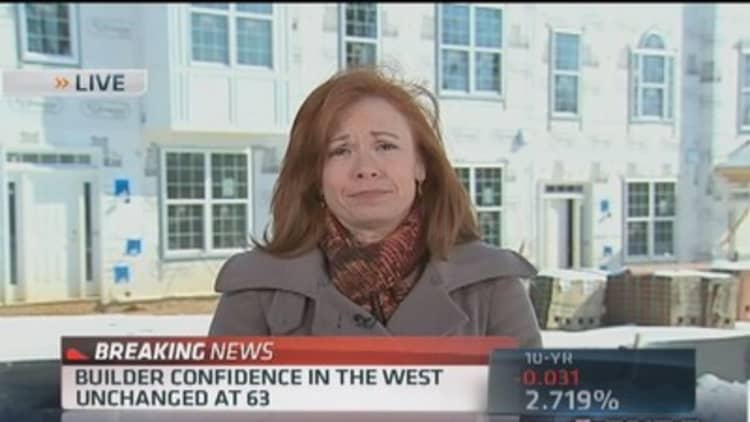
Sentiment among the nation's home builders fell dramatically in February, and while builders blame much of it on the weather, that is not the whole picture. Confidence fell 10 points, according to the National Association of Home Builders' monthly sentiment index, from 56 to 46—the largest drop in the history of the survey, which started in 1985.
Fifty is the line between positive and negative sentiment. The index has not been below 50 since May.
"Significant weather conditions across most of the country led to a decline in buyer traffic last month," said the association's chairman Kevin Kelly, a home builder and developer from Wilmington, Del. "Builders also have additional concerns about meeting ongoing and future demand due to a shortage of lots and labor."
Of the three index components, current sales conditions fell 11 points to 51, buyer traffic fell 9 points to 31 and future sales expectations fell 6 points to 54.
"Clearly, constraints on the supply chain for building materials, developed lots and skilled workers are making builders worry," said the home builder association's chief economist David Crowe. "The weather also hurt retail and auto sales and this had a contributing effect on demand for new homes."
(Read more: Beyond 'frozenomics': What's hurting the housing market)
Regionally, on a three-month moving average, builder confidence in the West was unchanged at 63 in February while the Midwest registered a 1-point decline to 57, the South registered a 3-point drop to 53 and the Northeast posted a 4-point decline to 38.
While it has been popular to blame much of the slowdown in the winter housing market on colder-than-average temperatures and higher-than-average precipitation, some argue that weather can only account for about a 1-2 percent drop in housing starts and home sales.
"Last month was cold, but it wasn't the coldest January of the Millennium," noted Jed Kolko, chief economist at Trulia.com.
(Read more: If investors bail on housing, what then?)
Kolko found, in an analysis of data from the National Climactic Data Center, that the average daily high in the Midwest was 27 degrees in January, 2014, 6 degrees below the Midwest's January normal. The Midwest had a slightly colder January in 2009; the Northeast had colder Januaries in 2003, 2004 and 2009.
"Even though the polar vortex was brutally chilling, some weeks in January were balmy," he said. In New York, for instance, the daily high temperature was above the January normal on 12 days out. And the West had its second-warmest January in 15 years, he said.
Kolko noted that Web searches do rise during especially bad weather, often with those in colder climates searching warmer areas. Typically, any construction hurt by cold weather is made up during the spring and summer, he added, but if other factors besides weather contributed to February's plunge, that may impact spring construction.
(Read more: Foreclosures could rise if Congress doesn't help)
CORRECTION: This version corrected the year the National Association of Home Builders' monthly sentiment index began: 1985.
—By CNBC's Diana Olick. Follow her on Twitter @Diana_Olick.
Questions?Comments? facebook.com/DianaOlickCNBC


